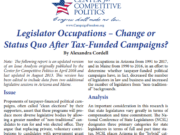Note: This report is an updated version of an Issue Analysis originally published by the Center for Competitive Politics in September 2008. This version has been edited to incorporate several additional measures of government spending.
Advocates of taxpayer-financed campaign programs often predict that these programs will actually save tax dollars by removing, or at least diminishing, the alleged influence of so-called “special interest” campaign donors.
If the claims of these advocates are correct, we would expect to find lower rates of government growth and spending in states with taxpayer-funded political campaigns. Two such states, Arizona and Maine, have implemented tax-financed campaigns for all state legislative races since 2000. This Issue Analysis compares spending growth rates and per capita expenditures in Arizona and Maine with the national average to determine if any predicted savings have materialized as a result of these two states’ tax-funded campaign programs.
Our analysis of Arizona and Maine’s taxpayer-funded campaigns programs demonstrates that these claims are untrue. In both states, the implementation of taxpayer-funded campaigns coincided with more rapid government growth and stable trends in per capita spending. Ultimately, there is no evidence supporting the contention that replacing private, voluntary contributions to candidates with tax dollars leads to savings for taxpayers, either in the form of decreased government growth or reduced per capita spending.
You can read Issue Analysis 4 here.
https://ifs-site.mysitebuild.com/wp-content/uploads/2013/11/2013-11-19_Issue-Analysis-4_Do-Taxpayer-Funded-Campaign-Actually-Save-Taxpayer-Dollars.pdf














